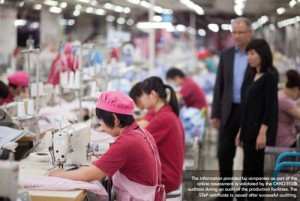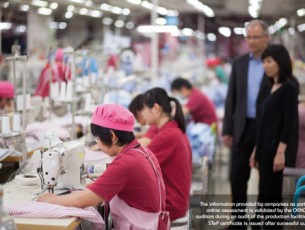 ZURICH – As of 1 April 2015, new requirements have been applicable for the certification of environmentally friendly and socially responsible production facilities in accordance with STeP by OEKO-TEX®.
ZURICH – As of 1 April 2015, new requirements have been applicable for the certification of environmentally friendly and socially responsible production facilities in accordance with STeP by OEKO-TEX®.
A list of the most important modifications to the STeP standard is given below:
•In the future, production sites certified in accordance with STeP must comply with new criteria relating to their wastewater. The following values are applicable:
•With immediate effect, chapter 4.5.13 of the STeP standard requires all employees to comply with ethically correct behavior. Specifically, this includes:
– Companies must provide their employees with a written Code of Conduct which defines the ethical principles of the company and lists corresponding specific directives.
– OEKO-TEX® will establish a neutral point of contact for employee complaints from STeP certified production sites.
– With regard to the purchase of feathers and down used in bedding or clothing manufacturing, STeP certified companies are required to obtain their raw materials from suppliers who can prove they do not adopt practices such as live plucking and/or forced feeding. OEKO-TEX® recommends that companies obtain proof from the suppliers by means of independent evidence such as the Responsible Down Standard (RDS) or comparable statutory certifications.
•The STeP criteria for the company area of “Social Responsibility” has been modified as follows:
– To exclude the worst forms of child labor, STeP certified companies must, in the future, also be able to provide evidence of compliance with ILO standard C182.
– If the employees of STeP certified companies receive additional donations from their employers, it must be clearly documented.
– Medical investigations required by law, for example, HIV tests, are not categorized by the STeP standard as discriminatory, but must be documented and monitored.
– All forms of slavery and forced labor, such as Sumangali which is practised in India, are categorically excluded. In addition, workers and salaried employees may use the toilets, drink water, and take a break at any time within the extent prescribed by law without fearing any disciplinary action.
•Banned processes that have a very negative influence on the environment and occupational health and safety will now be listed in Appendix D4 of the STeP standard (“Banned Chemicals and Processes”). Two new processes have also been included in the list of excluded processes. These are:
– Sandblasting for the treatment of jeans and other articles. Excluded from the ban are closed systems, provided that the dust emissions at the workplace do not exceed the limit value specified in Appendix G07 of the STeP standard.
– The use of thickening agents based on aromatic hydrocarbons for textile printing.
•The guidelines for production waste have been modified in the new STeP standard so that appropriate storage areas must be provided immediately to ensure that, wherever possible, pollution of the immediate environment and groundwater is excluded. This also specifies that the storage of production waste must be protected from external weather conditions and from fire. The objective for production companies is to ensure that the storage of production waste has no effect whatsoever on the environment.
•In the area of “Chemicals Management”, the list of banned and regulated substances for the manufacture of textiles (MRSL, Manufacturing Restricted Substances List) has been updated. The detailed changes are shown in Appendix D3 of the new STeP standard.
•Aside from the points already mentioned (e.g. the new regulations relating to the distribution of a Code of Conduct, sandblasting and the storage of production waste), the list of exclusionary criteria, whereby compliance with these criteria is a mandatory requirement for certification in accordance with STeP by OEKO-TEX®, was also expanded to include other aspects. This includes, for example, the specifications that each employee must receive a written employment contract, that the company ensures specific workplace conditions for young employees and that the payment of deposits for the recruitment of new employees is not permitted. The complete list of exclusionary criteria is available in Appendix M of the new STeP standard.
•The STeP standard can now also be applied to production companies for accessory parts for textile manufacture with immediate effect. More details on the updated requirements of STeP by OEKO-TEX® certification are available from the OEKO-TEX® Secretariat in Zurich, contact: info@ oeko-tex.com.
 SleepTech Magazine Mattress, Accessories, Machinery, Raw Materials
SleepTech Magazine Mattress, Accessories, Machinery, Raw Materials



